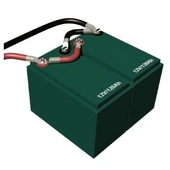Consumerbot3418
Fitting square pegs into round holes... for fun?
When I first started dipping my toes in the water with solar, I had a 3000W Windy Nation inverter w/ a Battle Born 100ah 12V battery. Later, I picked up a 2nd battery, and that's when I learned that The Right Way™ to connect a pair of parallel batteries is with the POS lead to one, the NEG lead to the other, and a jumper connecting both POS together, and both NEG together. Like this:

Now, I've been struggling with a pair of lead acid forklift batteries on a DC Solar trailer that aren't balanced well--when I'm discharging them, I can see a substantial imbalance in supplied current with my clamp meter. As it happens, they ran a pair of 4/0 wires to a point between the batteries, then used an Anderson wye to split and run POS and NEG to each battery. (The charge controller had its own smaller conductor run directly to just one of the batteries)
What I don't know is how much of a difference it really makes. I suppose doing it correctly (as above) means a loose connection or a poor crimp will equally impact both batteries, but that in a perfect world, running equal length identical conductors to both batteries should work equally well. Too bad we don't live in that perfect world!

Now, I've been struggling with a pair of lead acid forklift batteries on a DC Solar trailer that aren't balanced well--when I'm discharging them, I can see a substantial imbalance in supplied current with my clamp meter. As it happens, they ran a pair of 4/0 wires to a point between the batteries, then used an Anderson wye to split and run POS and NEG to each battery. (The charge controller had its own smaller conductor run directly to just one of the batteries)
What I don't know is how much of a difference it really makes. I suppose doing it correctly (as above) means a loose connection or a poor crimp will equally impact both batteries, but that in a perfect world, running equal length identical conductors to both batteries should work equally well. Too bad we don't live in that perfect world!


